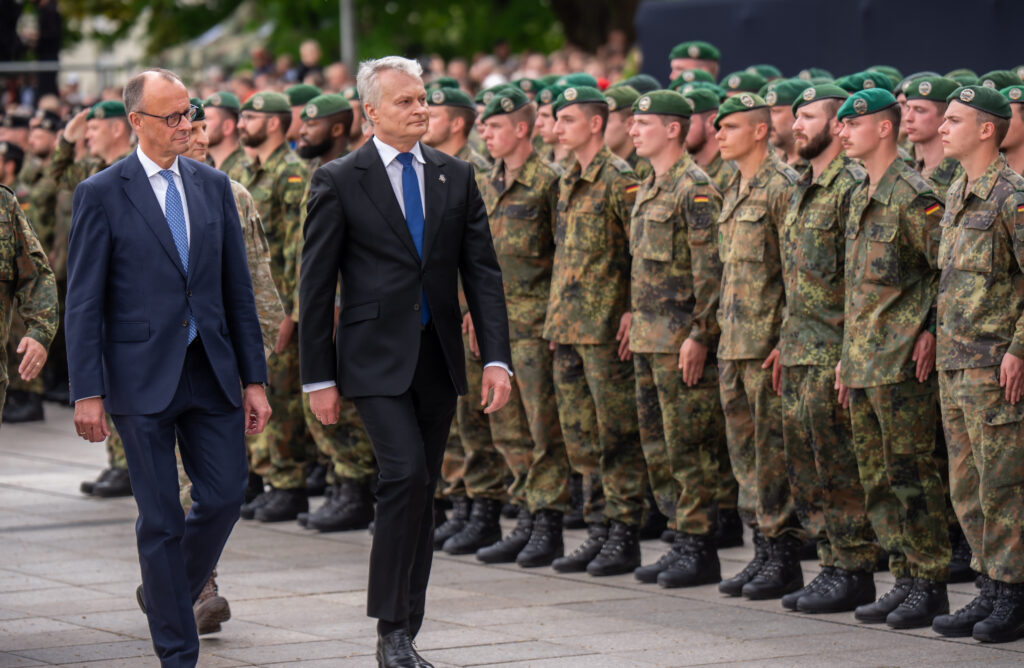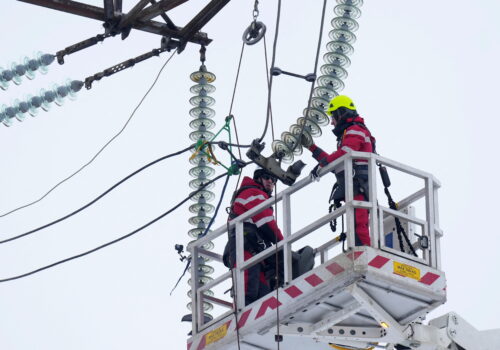“I am glad to be in Vilnius today,” said German Chancellor Friedrich Merz on May 22. “Because it is right here, in Lithuania, where we are taking the defense of NATO’s eastern flank into our own hands.”
Merz was in Vilnius to formally inaugurate the 45th Armored Brigade in Lithuania, which will embed German combat power at the heart of Baltic defense. Germany will implement a phased deployment—it sent advanced elements in early 2024 and formally activated the brigade on April 1. The brigade is expected to reach full combat readiness by 2027. Once complete, this will offer Lithuania and its neighbors a sustained, high-end deterrent anchored in the NATO framework.
But it’s not just Germany that is helping bolster the defenses of NATO’s strategically exposed eastern flank. The eastern flank countries themselves are implementing concrete measures to overcome Europe’s entrenched defense fragmentation. Finland, Estonia, Latvia, Lithuania, and Poland—all located along the eastern border of both NATO and the European Union (EU) with mainland Russia, its Kaliningrad exclave, and Belarus—are emerging as leaders in bolstering regional defense integration, the benefits of which could extend throughout Europe. This shift is especially significant amid growing transatlantic tensions and renewed calls from the United States for Europe to assume greater responsibility for its own security and conventional defense.
Since Russia’s full-scale invasion of Ukraine, these countries have aligned their border protection efforts by integrating their counter-mobility measures. They have initiated the process of cooperatively developing deep-strike capabilities. They have also started the procurement process for German weapon systems, introduced the German defense industry to the region, and will soon host the first-ever permanently deployed German brigade. All these initiatives show that Europe’s defense efforts are well-positioned to grow together and consolidate from the epicenter in the northeast of the continent. By anchoring their defense planning in regional realities, the eastern flank countries are demonstrating that regional coordination, backed by political determination, can transform exposed vulnerabilities into strategic assets that enhance deterrence and operational readiness.
Integrating counter-mobility systems
Faced with growing geostrategic pressure along their borders with Russia and Belarus, Finland, Estonia, Latvia, Lithuania, and Poland have taken decisive, coordinated steps to reinforce border protection and defense. Increasingly aligned in their strategic approach, these countries are developing integrated fortification systems that form a continuous defensive line along the eastern border of NATO and the EU.
Two major initiatives launched in 2024—the Baltic Defense Line covering Estonia, Latvia, and Lithuania, and Poland’s East Shield—share the common goal of strengthening deterrence and denying adversaries access to NATO and EU territory. These efforts include expanding existing forested areas, deepening drainage ditches, building engineering depots to store physical barriers such as “dragons’ teeth,” “hedgehogs,” “Spanish horse,” and solid concrete road barriers, as well as installing anti-tank landmines and mine-laying equipment. There are also plans for developing reinforcements with drone and anti-drone technologies. The overall goal is to ensure the two defense initiatives’ integrity, especially as they converge at the Suwałki Gap, a security chokepoint and the primary axis for NATO’s land reinforcement to the Baltic states.
Finland’s accession to NATO added 1,340 kilometers to the Alliance’s border with Russia. Unlike the more exposed terrain of the Baltic states and Poland, Finland’s border region is naturally defensive, dominated by forests, lakes, and wetlands, which would complicate a large-scale Russian ground incursion. Accordingly, Finland has chosen not to build physical fortifications along the border.
However, to reinforce deterrence and secure vulnerable segments, Finland aligned itself with the regional consensus by withdrawing from the Ottawa Convention banning the use of anti-personnel landmines. This means the eastern flank countries can jointly deploy and stockpile anti-personnel landmines as a shared border defense tool against Russia. Both Russia and Ukraine have used anti-personnel landmines in Ukraine.
The regional integration of border defense has triggered broader EU interest. Following Baltic and Polish calls for a collective response, the European Council’s conclusions on European defense, released on March 6, recognized the importance of EU border defense. The EU’s White Paper on Defense, published in late March, endorsed the idea of creating an “Eastern Border Shield” and in April, the European Parliament passed a resolution recognizing the East Shield and the Baltic Defense Line as flagship projects for common security. This momentum must now translate into concrete EU support—and funding—for transforming the eastern flank countries’ national efforts into a unified, layered European border defense architecture.
Coordinated development of deep strike capabilities
The Baltic states, Poland, and Finland are also integrating their long-range firepower into a regional deep-strike architecture, which significantly raises the threshold for aggression along the eastern flank of NATO and the EU.
Since Russia launched its full-scale war against Ukraine in 2022, Estonia, Latvia, and Lithuania have each contracted High Mobility Artillery Rocket Systems (HIMARS) launchers and committed to trilateral cooperation with the United States on HIMARS integration, personnel training, system maintenance, and service. Embedding HIMARS into a joint operational concept will allow the Baltic states to conduct combined live-fire exercises and harmonize sustainment through shared maintenance, training, and logistics chains. Estonia’s six launchers, delivered in April, now reach well beyond four hundred kilometers. Lithuania’s eight launchers, due to arrive by 2026, will achieve a similar reach. Latvia is set to receive six launchers in 2027, which will complete the Baltic deep-strike firewall.
This Baltic cluster is dovetailing with Poland’s even larger “Homar-A” deep-strike program, under which some 486 additional HIMARS variants will be mounted on Polish Jelcz trucks and integrated into Poland’s Topaz command system. Together, Poland and the Baltic states are planning a joint logistics hub to manage munitions stockpiles, spare parts, and forward displacement. They are also planning to exercise joint targeting and coordinate fire support across borders.
Finland has opted to upgrade its M270 multiple-launch rocket systems rather than buy HIMARS. The upgrade, approved in 2023, allows Finnish M270s to fire the same munitions as their Baltic neighbors. This technical alignment transforms Finland’s forces into a seamless fourth pillar of the regional deep-strike ensemble, enabling integrated planning, data‐sharing, and cross-border reinforcement exercises.
By integrating US-provided launchers, coordinated doctrine, shared logistics, and interoperable fire-control standards, the five eastern flank nations are establishing a continuous, multi-tiered long-range fire network that spans from Finland to Poland. This network helps project deterrence and complicate adversary planning, solidifying a new level of collective defense integration on the eastern flank.
Regional consolidation with German weapon systems
The eastern flank countries have also deepened their partnerships with German weapon manufacturers. Lithuania is aligning its force modernization with the German brigade’s forward posture in the Baltics. In December, Lithuania’s defense ministry signed a €950 million contract with for forty-four Leopard 2 A8 main battle tanks—its first indigenous tank battalion—which will arrive through 2030, alongside an expanded fleet of twenty-seven additional Boxer “Vilkas” infantry fighting vehicles, which will arrive by 2029. Finland and Poland likewise use Leopard 2 variants, creating a shared main battle tank backbone across the eastern flank.
In the air defense domain, Estonia and Latvia will each field three IRIS-T surface-launched missile batteries this year, while Lithuania has bolstered its two national advanced surface-to-air missile systems (NASAMS) batteries (initially deployed in 2020) with additional systems due to arrive in 2026. To underpin sustained operations, German arms manufacturer Rheinmetall’s new NATO-standard 155 mm ammunition plant in Lithuania, scheduled to be online by mid-2026, will produce tens of thousands of shells annually, significantly enhancing regional munitions resilience.
In the defense innovation field, Lithuanian laser technology firm Aktyvus Photonics has partnered with German drone manufacturer Quantum Systems, having signed a memorandum of understanding on strategic collaboration in unmanned systems this month. Together, they will codevelop and field-test unmanned aerial vehicles equipped with laser capabilities, aiming to expedite deployment timelines and establish a standard for next-generation, networked unmanned systems in NATO’s eastern defenses.
Beyond procurement, production, and innovation, Lithuania has also positioned itself as a regional arms maintenance hub: Through the establishment of Lithuania Defense Services—a joint venture between Rheinmetall Landsysteme and French-German defense manufacturer KNDS—it provides repair, overhaul, and upgrade services for German vehicle platforms, including Boxer Vilkas IFVs, PzH 2000 howitzers, the Leopard main battle tank family, and tactical logistics vehicles.
Collectively, these deployments, procurements, and industrial partnerships do more than fill capability gaps: They forge a contiguous eastern flank defense ecosystem. By standardizing on German platforms, harmonizing training and logistics, co-locating production and repair facilities, and co-training under unified command structures, Finland, the Baltic states, and Poland, together with Germany, can achieve unprecedented interoperability and strategic depth. These initiatives are transforming NATO’s eastern flank into a seamless, multi-domain bulwark.
Strategic depth through regional alignment
The eastern flank’s transformation from a collection of fragmented national postures into a cohesive, multi-domain defense network exemplifies how sustained regional integration can overcome long-standing capability gaps. By aligning border defense, harmonizing long-range fires, and embedding German heavy armor and sustainment infrastructure, Finland, Estonia, Latvia, Lithuania, and Poland are creating a continuous belt of deterrence that leverages shared doctrine, logistics, and industry. This holistic approach raises the cost of aggression and sets a new standard for European collective defense: one where interoperability and joint capacity-building replace duplication and dependency, anchoring strategic depth at NATO’s most exposed frontier.
Justina Budginaite-Froehly, PhD, is a nonresident senior fellow with the Atlantic Council’s Europe Center and Transatlantic Security Initiative in the Scowcroft Center for Strategy and Security.
Further reading
Thu, May 22, 2025
The case for a Three Seas Defense Innovation Hub
New Atlanticist By Justina Budginaite-Froehly
Because of increasing threats to critical energy, transport, and digital infrastructure, the Three Seas Initiative should add defense innovation as another pillar of its mission.
Wed, May 14, 2025
Inside Latvia’s race against time to build deterrence against Russia
New Atlanticist By
Latvia must convince its NATO allies to commit the necessary resources for its defense before Russia reconstitutes its forces.
Wed, May 7, 2025
Lessons from Latvia’s efforts to keep essential services running during a crisis
New Atlanticist By
Latvia has shifted its crisis-management thinking from a focus on infrastructure protection to an emphasis on continuity of essential services and functions.
Image: Federal Chancellor Friedrich Merz (CDU, l) takes part in the roll call of Panzerbrigade 45 alongside Gitanas Nauseda, President of Lithuania. The German Armed Forces' 45 Armored Brigade is permanently stationed in Lithuania and is intended to support NATO's eastern flank. Michael Kappeler/DPA via Reuters Connect.




